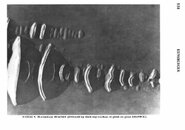I feel like this has become a cliff hanger... just waiting to get to the final outcome...
Like I posted earlier, knowing when to quit is an art. I don't want to drag this out, but there are a few more bits of work to be completed.
Much going on behind the scene. Tried a huge range of concentrations of the (miserable) slime polymer with ammonia. The two are compatible but the slime doesn't keep the ammonia from evaporating at any concentration. A spin-off is that polyethylene glycol (PEG) is an inert thickening agent. It is a mess to remove from hands and glassware. This suggests that a bit of PEG added to 10% baby soap might just be a really good anti-fog agent. (maybe someone will market it as Baby Spit?)
I'm now convinced that all current success is all about ammonia's ability to re-structure a glass surface. This also appears to be a self-limiting process so you can't over-do the ammonia.
@lexvil, in reply to one of your questions way upstream in this thread, yes, an ammonia-treated lens passed the ball-drop test. (n = 1 trials)
This puzzle piece just didn't fit with all the other observations:
Recently I had my wife mask that was VERY resistant to defogging. The dive store kept doing things that were not working (defog, shampoo...). ...//... I took some soft scrub and some very very fine sand (with soft scrub) and gently scrubbed the inside of the mask. It worked. ...//... If I put the mask under a microscope, I will probably see scratched. By naked eye, it looks good.
@Compressor, thanks for this observation. It now makes sense:
https://www.annualreviews.org/doi/abs/10.1146/annurev.ms.02.080172.002525
Look at what clean 'glass on glass' friction does. It is called 'stick-slip' microfracturing:

This compares well to the microstructuring that ammonia does to a glass surface. So, I've learned that a perfectly flat and clean glass surface in air produces all sorts of reflections. If the glass surface is 'trashed' at dimensions that are just smaller than the wavelength of incident radiation (for us, the visible spectrum), then the reflections are reduced or eliminated while transmission of light through the glass is increased. You can see this in any art musuem, the paintings are all protected by glass that you can't see as it doesn't reflect.
It looks like the very fine sand that you added to your Soft-scrub did a very similar thing that ammonia does.
In addition (quoting from the same paper concerning attacks on a glass surface):
"
Inorganic polyphosphates have the same ion-sequestering property, and consequently the same tendency to attack glasses. This attack is particularly severe in automatic dishwashers, where high temperatures and strongly alkaline detergents are the rule."
So a household ammonia treatment and your dishwasher seem to be well suited to each other as yet another good solution to mask fogging. I'm pretty sure the best way to clean, microstructure, and hydroxylate the glass surface is to first put the new mask into a dishwasher, then into a closed container with just enough household ammonia to assure coverage of the inside of the mask lens (leave it for 3-7 days), then use a dishwasher as needed to refresh the mask. That regimen should remove the need for high-octane mask defoggers. I still like either spit or baby shampoo.
Do what works best for you...






